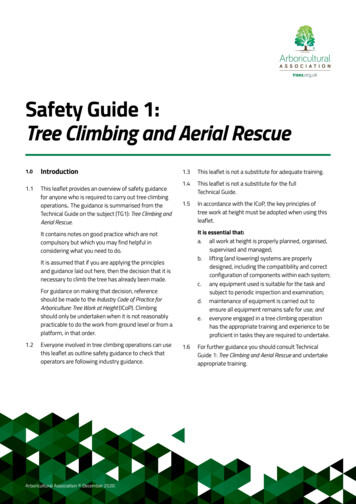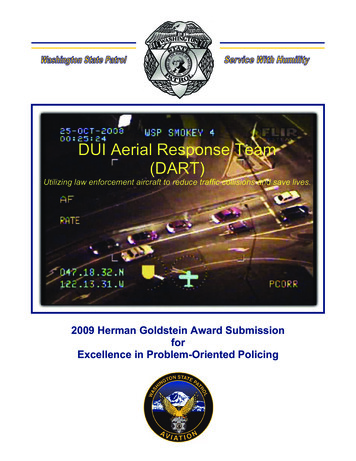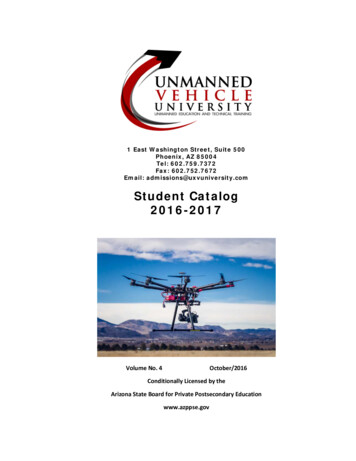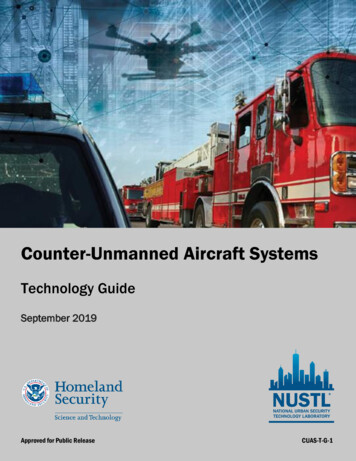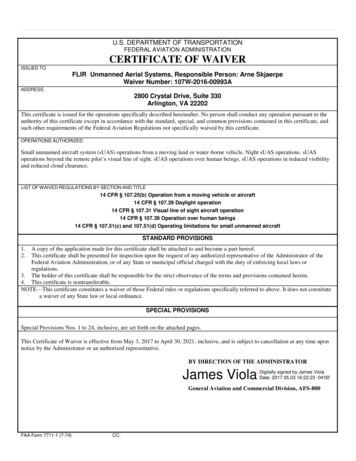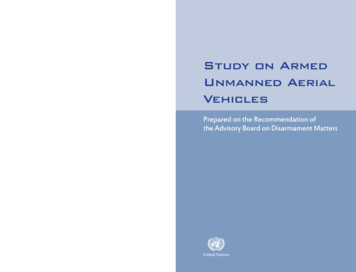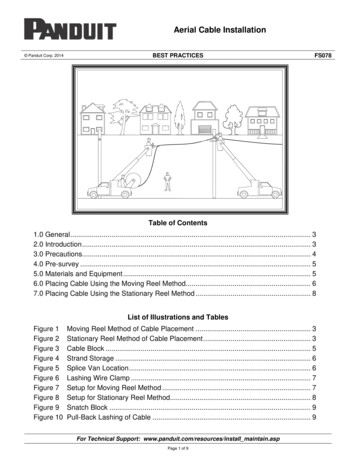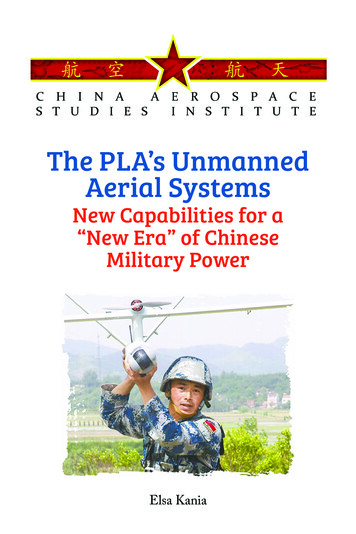
Transcription
The PLA’s UnmannedAerial SystemsNew Capabilities for a“New Era” of ChineseMilitary PowerElsa Kania
Printed in the United States of Americaby the China Aerospace Studies o request additional copies, please direct inquiries toDirector, China Aerospace Studies Institute,Air University, 55 Lemay Plaza, Montgomery, AL 36112Cover art is licensed under the Creative Commons Attribution-Share Alike 4.0International license. Credit for photos:E-mail: Director@CASI-Research.ORGWeb: r.com/CASI Research @CASI rThe views expressed in this academic research paper are those of the authors and donot necessarily reflect the official policy or position of the U.S. Government or theDepartment of Defense. In accordance with Air Force Instruction 51-303, IntellectualProperty, Patents, Patent Related Matters, Trademarks and Copyrights; this work is theproperty of the US Government.Limited Print and Electronic Distribution RightsReproduction and printing is subject to the Copyright Act of 1976 and applicabletreaties of the United States. This document and trademark(s) contained hereinare protected by law. This publication is provided for noncommercial use only.Unauthorized posting of this publication online is prohibited. Permission is givento duplicate this document for personal, academic, or governmental use only, as longas it is unaltered and complete however, it is requested that reproductions credit theauthor and China Aerospace Studies Institute (CASI). Permission is required fromthe China Aerospace Studies Institute to reproduce, or reuse in another form, any ofits research documents for commercial use. For information on reprint and linkingpermissions, please contact the China Aerospace Studies Institute.CASI would like to acknowledge the work and effort of CASI Associate Elsa Kaniafor her dedication to this and other CASI topics.
ForewordThe Chinese People’s Liberation Army (PLA) continues to work diligentlyon all aspects of their aerospace forces. This includes areas not only of traditionalaircraft, but also in more modern, and some cutting edge, technologies. The UAVis one area in which the People’s Republic of China, and the PLA in specific, hasinvested significant time and effort. While we recognize that the term “unmanned”is the common and official term, it is rather misleading in the fact that humans, atleast up until today, still play a critical role in their operations.Nonetheless, we will not buck convention at this moment, and continue touse “unmanned” for the ‘U’ in UAV, for this paper. The PRC is the world’s largestproducer of UAVs at this time, and captures a vast portion of the commercialmarket, as well as the military one. While it is important to keep the commercialaspects in mind, this particular paper will focus on military UAVs, theirdevelopment, deployments, and current and potential uses on the battlefield oftoday and tomorrow. The paper seeks to serve as a starting point to understandthis growing field, and to give analysts a common baseline from which to work,and from which to judge growth, both rapidity and complexity, in the future.We hope you will find this foundational paper useful and timely, andwelcome any feedback on its contents, or suggestions for further or futureresearch in this field.Dr. Brendan S. MulvaneyDirector, China Aerospace Studies InstituteThe PLA’s Unmanned Aerial Systems
2Chinese Aerospace Studies Institute
The PLA’s Unmanned AerialSystems – New Capabilitiesfor a “New Era” of ChineseMilitary PowerThe Chinese People’s Liberation Army (PLA) is actively advancing itsemployment of military robotics and “unmanned” (无人, i.e., uninhabited)asystems.1 To date, the PLA has incorporated a range of unmanned aerial vehicles(UAVs) (AKA “drones” or remotely piloted aircraft, RPA) into its force structure,2while also starting to experiment with and, to a limited extent, field unmannedunderwater vehicles (UUVs), unmanned ground vehicles (UGVs), and unmannedsurface vehicles (USVs).b The PLA’s history with unmanned systems dates backto its initial acquisition a basic target drone from the Soviet Union in the 1950s.Today, in its quest to advance military innovation, the PLA is engaged in cuttingedge research and development to create high-end unmanned, and increasinglyintelligent or autonomous, systems for all domains of warfare, ranging fromswarms of UAVs and USVs to hypersonic space planes.c, 3 This analysis firstprovides an overview of the PLA’s history with UAVs, next describes their likelymissions, then surveys the current unmanned aerial systems in service with thePLA, and lastly reviews the use of UAVs in relevant exercises (演习). Lookingforward, the PLA is actively developing these capabilities to enhance its militarypower, anticipating that future warfare will be “unmanned, intangible, and silent”(“无人,无形,无声”).4aThe use of the term “unmanned,” while common, is technically inaccurate, given the critical role ofhumans in their operation. Thanks to Paul Scharre for suggesting the alternative terminology of “uninhabited,” which is more appropriate. However, this paper will use “unmanned” as the translation of the Chinesephrase “无人,” since it typically rendered as such. However, “无人” could also be translated as “un-human-ed” or“human-less” (i.e., since 人 does not imply gender).bGiven CASI’s focus and mission, this paper looks primarily on the use of aerial (not ground, surface, orunderwater) vehicles by the PLA Army, Navy, Air Force, Rocket Force, and Strategic Support Force. As such,this analysis is not comprehensive, and the author recognizes that the development of unmanned ground,surface, and underwater vehicles by the PLA is also a major trend meriting further study and consideration.cThe PLA’s research and development of next-generation unmanned systems is the subject of a futureCASI paper based on ongoing research.The PLA’s Unmanned Aerial Systems3
PLA UAVs in Historical Perspective:The PLA’s history with the development and employment of unmannedsystems dates back decades. China acquired its first UAV, the Lavochkin La-17, abasic radio-controlled target drone, from the Soviet Union in the 1950s. Initially,these 20 La-17s were primarily used by the PLA Air Force (PLAAF) as targets,such as for tests of and training with weapon systems.5 After the Sino-Soviet splitand subsequent withdrawal of Soviet Union military support in the early 1960s,the PLAAF decided to develop its own unmanned systems, since the initial La17s were being rapidly used up without a viable replacement.6 This motivatedthe development, starting in 1965, of the PLA’s first notionally indigenous UAV,the Chang Kong – 1 (“Vast Sky,”长空一号, CK-1) UAV. The CK-1 was a radiocontrolled target drone based on a reverse engineering of the La-17, which wasinitially developed by the Nanjing University of Aeronautics and Astronautics,under the oversight of the former Commission for Science, Technology andIndustry for National Defense (COSTIND).7 The introduction of the CK1, which was first successfully tested around December 1966,8 facilitated PLAtesting and training, including for surface-to-air to missiles (SAMs), air-to-airmissile targeting, and air defense force training.9The La-17 and the CK-1 LaunchingDuring this timeframe, the PLAAF’s early testing and development of UAVstook place at the PLAAF’s Dingxin Test and Training Base’s 2nd Test Stationin the Gobi Desert.10 The researchers involved in this process included PLAAFspecial technical officer/cadre Zhao Xu (赵 煦), who has been hailed as China’s‘father’ of UAVs.11 Leading the Chang Kong research group, Zhao Xu pioneeredearly breakthroughs, resolving basic problems in its performance. At that point,China’s technical backwardness rendered progress very slow, but this developmentof China’s first indigenous drone is celebrated as a milestone that established aninitial foundation for the future development of unmanned systems.Also in the 1960s, the PLA recovered a number of U.S. AQM-34 Firebeedrones, used for surveillance,12 of which eleven were shot down in North Vietnamby PLAAF J-6 fighter jets starting in late 1964.13 The Firebee was later reverse4Chinese Aerospace Studies Institute
engineered to develop the Wu Zhen – 5 (无 侦-5, WZ-5), created by BeihangUniversity (the Beijing University of Aeronautics and Astronautics), which hadentered service with the PLA by 1981, primarily for military reconnaissance.14 Itsexport version was known as the Chang Hong – 1 (长虹-1 号). In 1979, the WZ-5was reportedly employed for reconnaissance in China’s “self-defensive counterstrike” (自 卫反击) against Vietnam.15The AQM-34 and WZ-5By the late 1970s and into the 1980s, the PLAAF sought to develop targetdrones with performance similar to that of combat aircraft to test new weaponsystems. These were created from decommissioned Soviet MiG-15 aircraft inwhat was known as the Wu Yi target (靶—五乙) drone, tested successfully in1984, which was then used as a target for weapons tests, particularly of air defensesystems.16 China’s J-6 (歼-6) fighter jet also appears to have been converted foruse as a drone, to serve either as a target or potentially for combat purposes,particularly since its large-scale retirement.17 The PLA likely continues to convertcertain fighter jets to drones as it retires them.At that point, Chinese military research and development was already startingto focus on advanced capabilities in target drones. As early as the 1960s, Chinawas funding the development of a supersonic unmanned drone as a target fortests, particularly of air-to-air missiles.18 Although initial efforts were unsuccessful,after Zhao Xu took the lead on this project, his team was able to overcome majorobstacles, including the lack of a full digital control system, to control and stabilizethese supersonic target drones with an analog system.19 By April 1995, the testflight of this supersonic target drone was reportedly a success, making China thethird country in the world, after the U.S. and Russia, to have developed such asystem.20The PLA’s Unmanned Aerial Systems5
China’s Supersonic Target DroneSubsequently, Zhao Xu turned his attention to the development of a ‘newtype’ UAV capable of autonomous (自主) navigation and flight and automatic(自动) return for landing, before continuing in the development of further multipurpose UAVs.21Zhao XuZhao Xu, who remains actively involved in UAV R&D as of 2018 as anacademician with the Chinese Academy of Engineering,22 has highlighted thatthe future direction of PLAAF UAV development will enable their emergence asa “second air force” for China.23Over the next several decades, China’s development of unmanned aerialsystems continued based on a combination of reverse engineering and indigenousdevelopment.d For instance, the Cai Hong series of UAVs, developed by the ChinaAerospace Science and Technology Corporation (CASC) starting in the 1990s,has since progressed considerably. CASC’s CH-3 and CH-4 have primarily beenexported as unmanned combat aerial vehicles (UCAVs) to militaries worldwide,including Iraq, Egypt, Saudi Arabia, Myanmar, and the United Arab Emirates.24dFor more details on current trends in research and development, please see the next paper in this series.The subsequent sections of this paper also discuss the process of development for particular systems.6Chinese Aerospace Studies Institute
The CH-4 in IraqIn the meantime, a range of UAVs has entered service throughout the PLAfor a number of missions that enable and support military capabilities.Primary Missions of PLA Unmanned Aerial Systems:Today, the PLA is focused on leveraging UAVs to engage in and support awide range of missions and operations across all domains of warfare, informedby its history and early concentration on their development.e On the futurebattlefield, military robotics and unmanned, increasingly autonomous systemscould become pervasive.PLA Cartoon with Options for the Employment of UAVsWeapons Testing and TrainingThe PLA’s early history with drones focused on their utility as targets forweapons testing and training, and this application remains relevant to this day asthe PLA seeks to enhance the sophistication of its training.25 For instance, in 2018,the PLA Navy has used target drones in drills in the South China Sea, seekingePlease note that this section is not intended to be comprehensive but rather provides a quick overviewof prevalent missions at present and in recent history. As its development of unmanned systems progressesfurther, the PLA will continue to explore further applications for them.The PLA’s Unmanned Aerial Systems7
to enhance its actual combat capability through a simulated missile attack drill.26The target drones, which had reportedly been employed several hundred timesin over 30 previous exercises and training missions, were reportedly intended to“precisely simulate the feasibility and effectiveness to ensure a close simulationof an aerial attack target,” while exploring more innovative approaches to actualcombat (实战) training.27Surveillance and Reconnaissance:The PLA’s employment of unmanned aerial systems will support itsintelligence, surveillance, and reconnaissance (ISR) capabilities, from tacticaldrones used for battlefield reconnaissance to systems that are more sophisticatedin supporting long-range surveillance. In this regard, these systems will enhancePLA situational awareness in complex environments.28Targeting and Battle Damage Assessment:The PLA will use UAVs to enable targeting and battle damage assessments,including in directing artillery or enabling over-the-horizon (OTH) targeting ofmissiles.29 Increasingly, certain UAVs have even been integrated with the PLA’scommand information systems.30 From tactical fires to precision strikes, UAVshave the potential to ensure greater precision and thus enhance PLA firepowercapabilities.Data Relay and Communications Support:The PLA will likely utilize multiple models of UAVs for data relay, includingto support communications.31 In a scenario in which space-based capabilities werecompromised, the PLA might utilize UAVs to replace that capability, at least at alocalized level, which could facilitate its operations in a denied environment.Information Operations:The PLA will leverage UAVs in information operations, especially toundertake electronic countermeasures to gain advantage on an “informatized”(信息化) battlefield,32 including within a joint force information operationsgroup (信息作战群).33 In particular, information operations are believed to bedeveloping in the direction of unmanned technologies, since UAVs have becomea “multipurpose electronic warfare platform capable of executing a variety ofelectronic warfare tasks,” which include electronic reconnaissance, electronicjamming, and anti-radiation attacks, according to influential Academy of Military8Chinese Aerospace Studies Institute
Science information warfare theorist Ye Zheng (叶征).34 UAVs may also be usedas ‘bait’ or decoys in order to confuse enemy forces.35Suppression (or Saturation) of Enemy Air Defenses:The PLA could employ anti-radiation UAVs, such as the Harpy and theindigenous ASN-301 adaptation of it, in support of the suppression of enemyair defenses.36 In addition, the mass of swarms of ‘suicide drones’ could also beleveraged to overwhelm air defenses or high-value weapons platforms. The PLAhas seemingly converted its retired J-6 fighters into drones that have been massedand likely remain at bases in Fujian Province near Taiwan.37, 38 There are concernsthat these drones could be used to overwhelm Taiwan’s defenses in a conflictscenario.39 In an exhibit on future warfare, China’s Military Museum in Beijingalso includes an image of a “swarm combat system” going up against an aircraftcarrier.40A Depiction of the PLA’s Future Swarm Combat SystemIntegrated Reconnaissance and Precision Strike:Some of the PLA’s advanced UAVs are optimized for integrated reconnaissanceand strike (察打一体), capable of carrying multiple types of precision weapons.These capabilities might be utilized in conventional conflict or counterterrorismscenario.41 For instance, a PLA strategist from the Academy of Military Sciencehas argued that advanced UAVs could be used for power projection in “longThe PLA’s Unmanned Aerial Systems9
distance operations,” in order to enable the PLA’s “long-arm counterattack”capabilities.42 The PLA Navy might employ ship-based and carrier-based UAVs,43including to strike an adversary’s aircraft carrier or to assault an enemy-occupiedisland or reef.44Logistics Support:The PLA will likely use UAVs for logistics support, particularly for scenariosrequiring rapid response, given their advantages of speed, accuracy, and flexibility.In some cases, the leveraging of commercial partnerships may be a major enabler.For instance, the PLAAF Logistics Department has developed a strategiccooperation agreement through which the commercial UAVs from SF Expressand Jingdong were used for rapid delivery of medical supplies and equipment forrapid repairs in a trial exercise in January 2018.45A Commercial UAV in Action10Chinese Aerospace Studies Institute
UAVs Across the PLA TodayThe PLA has fielded a range of UAVs across all four services, the PLA Army(PLAA), Navy (PLAN), Air Force (PLAAF), and Rocket Force (PLARF/formerSecond Artillery Force); as well as the Strategic Support Force (PLASSF).f Inaddition, the former General Staff Department Intelligence Department (情报部),now the CMC Joint Staff Department ( JSD) Intelligence Bureau (情报局), usedto operate UAVs for reconnaissance and intelligence.46 There are some indicationsthat this unit (61135 部队) has since been transferred to the PLAAF,g seeminglyre-designated as Unit 95894 in the process,47 but the JSD may continue to operatea limited number of UAVs.hAlthough a high proportion of the UAVs in service with the PLA are smaller,tactical models, the PLAAF and PLAN have also started to introduce growingnumbers of advanced, multi-mission UAVs. Certain PLA UAVs appear to bestrikingly similar to comparable U.S. models, which may reflect mimicry orcyber-enabled theft of intellectual property in some cases.48 At the same time, forsmaller or less specialized unmanned systems, such as those used for logistics ortactical reconnaissance, the PLA is seeking to take advantage of the strength anddynamism of China’s commercial drone industry, pursuant to a national strategyof military-civil fusion (军民融合).49 Given the robust and extensive researchfPlease note that this is not intended to be a comprehensive overview of all of the UAVs that the PLAoperates but rather a review of representative models. This listing is not comprehensive, and it does not includethose systems currently in development but not known to be fielded.gSpecifically, these UAVs were assessed to be operated by the Tactical Reconnaissance Bureau (战术侦察局),also seemingly referred to as the Aerospace Reconnaissance Bureau (航天侦察局), which appeared to oversee thisoperational UAV unit located in Shahe, Beijing. (Ian Easton and L.C. Russell Hsiao, “The Chinese People’sLiberation Army’s Unmanned Aerial Vehicle Project: Organizational Capacities and Operational Capabilities,”Project 2049 Institute, March 11, 2013, https://project2049.net/documents/uav easton hsiao.pdf.)hFor instance, the 55th Research Institute, which is involved in UAV development, may remain under theJoint Staff Department.The PLA’s Unmanned Aerial Systems11
and development underway, a range of advanced, next-generation unmannedsystems, including those that are solar, stealthy, supersonic, and/or increasinglyautonomous, will enter into service with the PLA in the future.50PLA Army:The PLA ground forces employ a range of UAVs that are primarily smaller,more tactical models, often utilized for battlefield reconnaissance and targetingartillery fire to enhance precision strike. To date, a significant proportion of theseUAVs has come from a series produced by the Xi’an Aisheng (ASN) TechnologyGroup, Ltd., which is subordinate to Northwestern Polytechnical University inXi’an.51 This organization has reportedly delivered thousands of UAVs to the PLAin the past several decades and claims to hold as much as 90% of the ChineseUAV market.52 In the PLAA, a range of units and organizations incorporateUAVs controlled by operators and supported by military technicians. The PLAAhas equipped reconnaissance UAVs in brigade-level (旅) units. For instance, theNorthern Theater Command sent several UAV fendui (分队)i that were assignedto brigade-level forces to undertake OTH reconnaissance training.53 There arealso a number of dedicated UAV battalions (无人机营) and a variety of lower-levelorganizations with UAVs (i.e., fendui, 分队, or ‘teams,’ 队) across all five theatercommands (战区), often subordinate to group armies.As of the mid-1990s, the JWP-01 (ASN-206) was introduced as a multipurpose UAV with a range of about 150 kilometers.54 It was used primarily insupport of artillery, enabling reconnaissance and assisting in targeting. Theinformation, such as video imagery, captured by the UAV, could be transmittedto ground stations, where the command team could use the information withthe capability to direct and position targeting, including artillery fire.55 Therealso appear to have been several variants of it, such as the RKL-165, which wasreportedly developed as a “false target drone” used as a decoy to draw enemy fire,and the TK-J226, seemingly employed for communications relay.56iThe term fendui is typically used to describe platoon to battalion-sized subunits, whereas units includeregiments, brigades, divisions, and corps-level organizations.12Chinese Aerospace Studies Institute
The ASN-206The successor to that model, the ASN-207 (or JWP-02),j features an improvedrange, reportedly up to 600 kilometers, and overall greater performance.57 Featuredin China’s 2009 National Day Parade,58 it has likely also been adapted for severaldifferent variants.k The ASN-207 can be readily distinguished by its mushroomshaped receiving antenna.ASN-207 on ParadeIn China’s August 2017 military parade, a PLAA UAV was displayed as partof a UAV formation (无人机方队) within the information operations group (信息作战群 ).jThere is some confusion and inconsistency in how the designations JWP-01 and JWP-02 are applied tothe ASN-206, ASN-207, and other ASN-series UAVs in open-source analyses and reporting. These modelscan also be difficult to distinguish (and are often mislabeled) in available imagery. I try to differentiate thesemodels to the best of my ability, relying upon authoritative sources as much as possible.kAccording to some sources, which cannot be fully verified, the variants of the ASN 206/207 include:the RKT-164/RKT-167 communication jamming variants; the TK-J226 for communications relay; theRKL-165 as a decoy and false target; the DCK-006 for reconnaissance; and the RKZ-167 for electroniccountermeasures.The PLA’s Unmanned Aerial Systems13
UAV Formation in the Information Operations GroupThis parade displayed a number of ‘new-type’ UAVs for radar andcommunications interference, intended to disrupt adversary commandinformation systems.59 The PLAA UAVs participating in the parade came from aCentral Theater Command Army Infantry Division’s Electronic CountermeasuresBattalion.60UAVs on Parade in August 2017Increasingly, the PLA’s UAVs have started to be integrated with its commandinformation systems to enable their use to guide firepower (i.e., kinetic) strikes.61For instance, as of August 2016, the former Central Theater Command’s 20thGroup Army (decommissioned as of 2017), which was experimenting with theuse of a new type of command information system, engaged in exercises in whichit demonstrated the successful application of firepower targeting based on footagesent back from an ASN-series UAV.62 Through such employment of UAVs, unitshave the ability to undertake damage assessments of targets and decide whichrequire another wave of strikes.63The PLA has also leveraged UAVs for surveying and mapping of operationalgeography, transmitting data and imagery to enhance situational awareness on thebattlefield.In addition, certain PLAA units, including special forces and armored brigadeshave been provided with smaller, hand -held and -launched variants, including theCH-802 for localized reconnaissance.64, 6514Chinese Aerospace Studies Institute
CH-802 with PLA Army Special ForcesPLA Navy:The PLAN possesses not only smaller tactical UAVs but also a limited numberof sophisticated reconnaissance UAVs. Notably, the PLAN operates the mediumaltitude long endurance (MALE) BZK-005 or Chang Ying (长鹰), which has amaximum range of 2,400 kilometers and a maximum endurance of 40 hours.66 TheBZK-005, designed by the Beihang University’s UAV Institute and the HarbinAircraft Industry Group is thus roughly comparable to the U.S. Global Hawk.67The BZK-005’s development dates back to 2000, under the leadership of chiefdesigner Xiang Jinwu (向锦武),l and it underwent testing and verification 2006,ahead of being finalized and delivered around 2007.68, 69BZK-005 on parade and in flightThe BZK-005 has been operating in the vicinity of the East China Sea sinceat least 2013, when, according to Japanese media, the BZK-005 entered Japan’sADIZ in the East China Sea and was intercepted by Japanese fighter jets.70 Basedon satellite imagery, there were at least three BZK-005 UAVs stationed at thePLAN airfield on Daishan Island in Hangzhou Bay in the East China Sea as ofmid-2015.71 In addition, by mid-2016, there were also reports that the PLAN haddeployed at least one BZK-005 UAV to Woody Island in the South China Sea,lIn both 2009 and 2018, the team responsible for its design received a first place in the National Scienceand Technology Progress Award for their accomplishments.The PLA’s Unmanned Aerial Systems15
based on satellite imagery,72 though it has not been clear whether or not it may bestationed there permanently in the future.73The PLAN has also operated a medium-altitude, medium-endurance(MAME) UAV, a variant of the ASN-209 known as the “Silver Eagle,” (银鹰),fielded since at least 2011, which has been used for long-distance communicationssupport and electromagnetic confrontation.74 In a scenario in which satellitecommunications were compromised, the PLA might utilize UAVs to replace thatcapability, at least at a localized level. The PLAN might also use these UAVs,which have a range of 200 kilometers and maximum endurance of 10 hours, asguidance for targeting missiles. While PLAN UAVs may be especially prevalentin the Eastern Theater Command Navy, all three theater command navies appearto have fielded at least a limited number of UAVs.75The ‘Silver Eagle’ LaunchingPLAN vessels are also known to operate UAVs and unmanned helicoptersfor use in support of maritime ISR capabilities. The S-100, purchased in 2010from the Swedish company Schiebel, has been observed operating off of PLANsurface combatants, including the Type-054 frigate.76 Going forward, the PLANwill likely continue to field and integrate further UAVs and unmanned helicoptersinto its fleets, including the WZ-6B unmanned helicopter, developed indigenouslyby the former General Staff Department’s 60th Research Institute,m which has arange of 200 kilometers and maximum endurance of 6 hours.77m This institute is also known as the Nanjing Research Institute of Simulation Technology, and it has likelyshifted under the CMC Equipment Development Department since the reforms.16Chinese Aerospace Studies Institute
As of early 2018,n the Xiang Long (“Soar Dragon,” 翔龙), which was initiallyseemingly designated the EA-03 but now apparently referred to as the WZ-9 (无侦-9), has also been fielded with the PLAN.78 The Xiang Long is a high-altitudelong endurance (HALE) UAV, with a range of 7,000 kilometers and maximumendurance of 10 hours, which was designed by AVICs Chengdu Aircraft Designand Research Institute and produced by AVIC’s Guizhou Aviation AircraftCorporation.79 So far, according to available reporting, the Soar Dragon has beentested in the Southern Theater Command Navy (former South Sea Fleet),80 and ithas been spotted at the Lingshui Naval Airbase on Hainan Island, where it couldbe used in support of airborne early warning.81The ‘Soar Dragon’The Xianglong was initially revealed in 2006 at the Zhuhai Airshow.82 In2011, a prototype of it was photographed at an airfield in Chengdu, and its firstsuccessful flight occurred in 2013.83 As of the summer of 2016, photos onlineappeared to indicate that the Xianglong had entered production,84 and by late2016, there were reports in state media that it was undergoing final testing andcould soon enter service with the PLA.85PLA Air Force:The PLAAF has fielded the GJ-1 (Gongji-1, 攻击-1,) variant of thePterodactyl (or Yilong, 翼龙), a medium-altitude long-endurance (MALE) UAVwith a range of 4,000 kilometers and maximum endurance of 20 hours, developedby China Aviation Industry Corporation’s Chengdu Aircraft Design Institute.The GJ-1, which is roughly analogous to the U.S. Predator, is capable of carryingat least ten forms of precision weapons, including air-toground missiles, precisionguided rockets, and precision-guided bombs.86 Equipped with an optical turret,infrared and photoelectric sensors, and laser target pointers, the GJ-1 can guidenIt is quite possible that this UAV may have been fielded sooner, but these initial reports of its fielding anddetection date back to that timeframe.The PLA’s Unmanned Aerial Systems17
the targeting of anti-tank missiles that it launches and also provide targetinginstructions for other aircraft or ground weapons.87The GJ-1The GJ-1 is known for its integrated reconnaissance and strike capabilities,but it can also be used fo
The PLA’s Unmanned Aerial Systems The Chinese People’s Liberation Army (PLA) is actively advancing its employment of military robotics and “unmanned” (无人, i.e., uninhabited)asystems.1 To date, the PLA has incorporated a range of unmanned aerial vehicles (UAVs) (AKA “drones” or re

